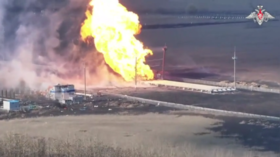ISIS 'minister of war' al-Shishani likely killed in airstrike – Pentagon

Georgian-born Abu Omar al-Shishani, a top Islamic State commander and Caucasus jihadist recruiter, is thought to have been killed in an air raid in Syria, US officials say, but local forces have not yet confirmed the death of America's most wanted man.
Also known as Omar the Chechen, 30-year-old al-Shishani is believed to have been a close military adviser to the infamous leader of Islamic State (IS, formerly ISIS/ISIL), Abu Bakr al-Baghdadi. Until recently, al-Shishani led a brigade of foreign jihadist fighters responsible for a series of beheadings and suicide bombings in northern Syria.
The airstrike was conducted last Friday, and involved multiple waves of manned and unmanned aircraft that targeted al-Shishani near the town of al-Shaddadi in eastern Syria, Reuters reported on Tuesday. Al-Shaddadi had earlier been retaken by US-backed local militia after months under IS control.
According to a Department of Defense press release, the US military is still assessing the results of the strike, without providing further details. The statement added that at the time of the strike, al-Shishani had been sent to al-Shaddadi to bolster IS militants demoralized after a series of defeats by local US-backed forces near the Syrian-Iraqi border.
Speaking to Reuters on condition of anonymity, several US officials expressed optimism that the strike had been a success, although none could confirm al-Shishani’s death.
A source in the Syrian Kurdish YPG militia, which has been engaging IS militants near al-Shaddadi, said the group had received information that al-Shishani had been killed but was also unable to confirm the death.
Al-Shishani is ranked among America's most wanted terrorists under a US program which offered up to $5 million for information to help take him out.
The Department of Defense statement described al-Shishani as Islamic State’s “minister of war.” It added that his potential killing would have a negative impact on the ability of IS to recruit foreign militants, particularly those from Chechnya and the Caucasus. His alleged death also means that the terror group would be stripped of the ability to coordinate attacks and defend its strongholds in Raqqah, Syria, and Mosul, Iraq.
Al-Shishani – real name Tarkhan Batirashvili – was born to a Georgian-Chechen family in the Pankisi Gorge region of Georgia.
Before becoming known to the West as one of the bloodiest jihadist commanders, he lived a quiet life in the tiny village of Birkiani and worked as a shepherd. In 2007, he joined the Georgian Army and quickly progressed through the ranks. Several media reports say he was in a special reconnaissance group and stood out due to his proficiency with firearms and maps.
As an army sergeant and forward artillery observer, he took part in the Georgian Army’s offensive on the South Ossetian capital Tskhinval in 2008, which claimed hundreds of civilian lives. Al-Shishani allegedly became a jihadist after his failure to get promoted as an officer, followed by a 16-month prison term for illegal weapons possession.
He moved to Syria in 2012 and participated in several Islamist offensives in Aleppo and Latakia against the Syrian Army. A senior IS commander from 2014, he was reported dead on numerous occasions. In 2015 alone, there were reports in May, June and October that he had been killed in various parts of Syria, but all proved to be untrue.
The airstrike on al-Shishani adds to a long list of similar US-launched targeted killings – only a few of which have proved efficient. Most assassinations were conducted through US drone strikes, intended to be a “surgical weapon” against terrorists, but remarkable for their poor capability to verify the results on the ground.
Jordanian-born Ayman al-Zawahiri, the current leader of Al-Qaeda and mastermind of the 2000 USS Cole terror attack, has been declared dead numerous times but still has not been killed.
In 2006, several CIA Predator drones fired as many as 10 Hellfire missiles on the Pakistani village of Damadola, killing and injuring dozens of civilians. Two weeks later, al-Zawahiri appeared on a video unhurt and discussed the failed assassination attempt. In 2008, US media reports said al-Zawahiri was critically injured in another US missile strike at Azam Warsak village in Afghanistan, which later proved to be false. Still alive and at large, al-Zawahiri is wanted dead or alive, with the US Department of State offering a reward of up to $25 million for any data on his whereabouts.
READ MORE: US conducts ‘counter-terrorism’ airstrike in Libya, unsure of result
A senior Al-Qaeda commander in Northern Africa, the notorious Mokhtar Belmokhtar, was also reported killed several times with unverifiable outcomes. In 2013, the Chadian military claimed Belmokhtar was killed during an assault on an Islamist rebel base which was “completely destroyed” in an attack. He was known for orchestrating the deadly attack on an Algerian gas plant in January 2013 in which 800 people were taken hostage, 39 of whom were executed.
In 2015, the Pentagon announced it had conducted an airstrike in Libya targeting the one-eyed Algerian jihadist war veteran nicknamed “Mr. Marlboro.”
As in the case of al-Shishani, the Department of Defense was unclear of the results and provided no details, adding that there had been no US boots on the ground assisting the operation.















